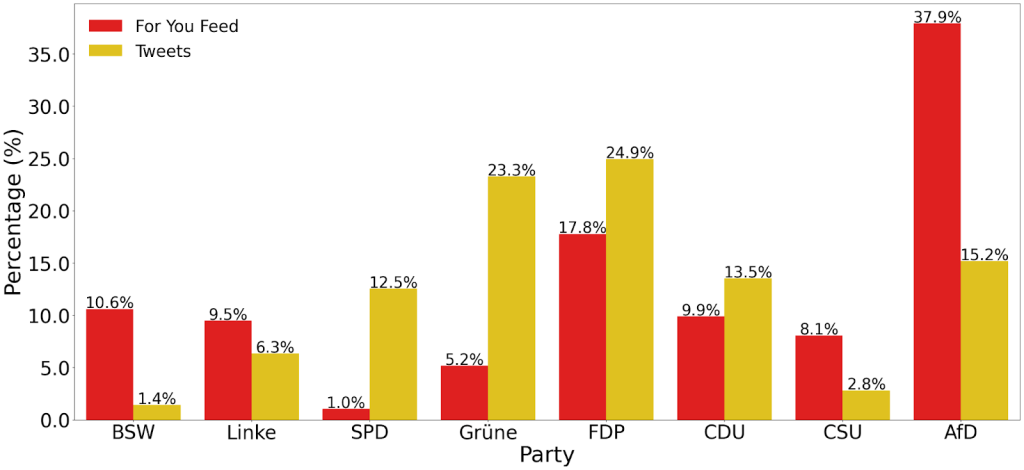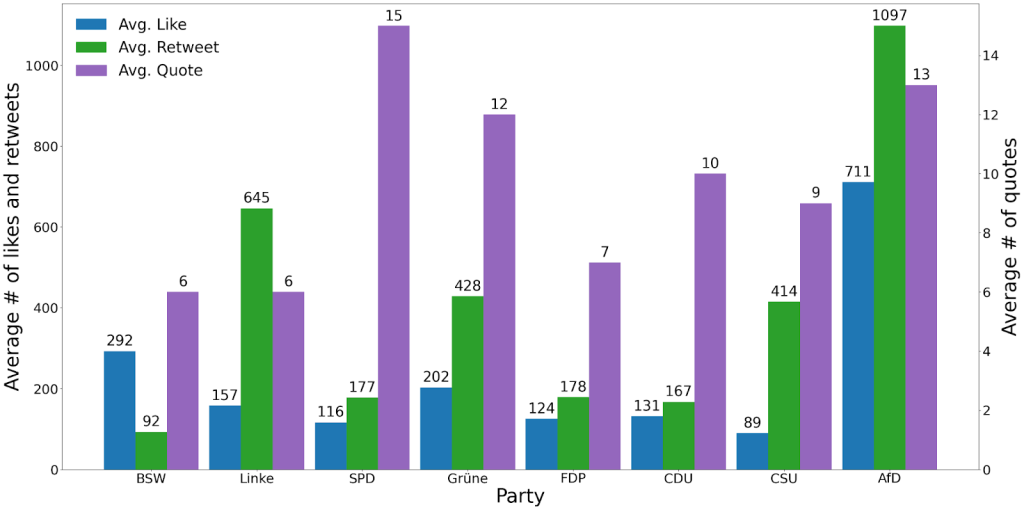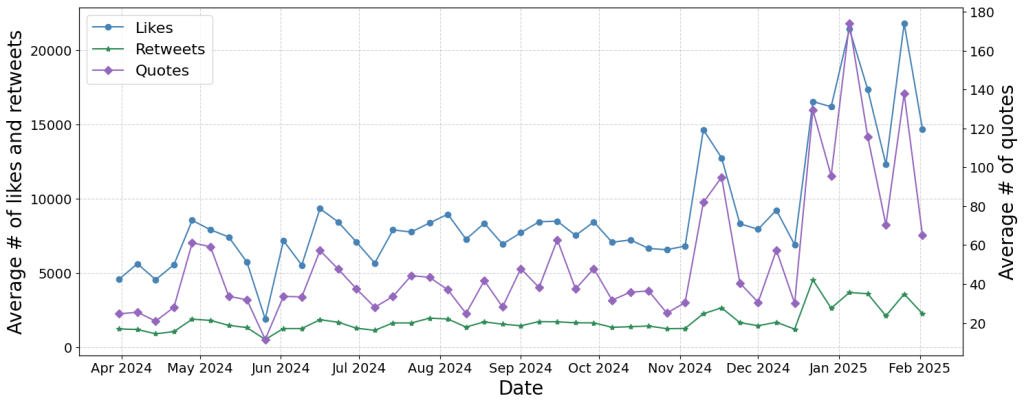Political Biases on X before the 2025 German Federal Election
By

This study examines whether German X users would see politically balanced news feeds if they followed comparable leading politicians from each federal parliamentary party of Germany. We address this question using an algorithmic audit tool [1] and all publicly available posts published by 436 German politicians on X. We find that the default feed of X showed more content from far-right AfD than from other political parties. We analyze potential factors influencing feed content and the resulting political non-representativeness of X. Our findings suggest that engagement measures and unknown factors related to party affiliation contribute to the overrepresentation of extremes of the German political party spectrum in the default algorithmic feed of X.
X users can choose between two content feeds, called For You and Following feeds. The default feed is the For You feed. Both feeds rank content algorithmically, but the Following feed contains posts exclusively of users followed by the feed owner, prioritizing recent content. By contrast, only 20% of posts shown in the For You feed are from the users they are following.
We created two likewise sock-puppet X accounts1, made them follow the same set of German politicians, and tracked their feeds for 4 weeks, from January 3 noon to January 31 noon German time, by opening and saving the first page (35 posts) of each of their feeds every half an hour. The sock puppets followed 64 users on X – seven to nine members from each of the eight major German federal parliamentary parties (ordered from left-wing to right-wing, starting with BSW, which is considered left-authoritarian [2]: BSW, Linke, SPD, Greens, FDP, CDU, CSU, AfD). To better understand the factors that determine post appearance in the For You feed, we collected tweets of all German parliamentarians who have X accounts (436 politicians) and other users most appearing in the For You feed (69 users), including the 64 politicians followed by the sock-puppet accounts (see an overview in Table 1 of our full research report).

Figure 1: The fraction of the For You feed occurrences (red bars) and posts on X (yellow bars) in January 2024 of the 436 members of eight German political parties, ordered by their political ideology: from far left (BSW) to far right (AfD).
We find that the posts of the far-right AfD politicians appeared most frequently in the For You feed, accounting for about 37.9% of posts in the feed, even though the AfD politicians posted only 15.2% of the tweets by politicians during this time (see Figure 1). Similarly, the posts of the other German populist party, the left-wing BSW, appeared 10.6% times in the For You feed, despite the fact that their politicians created only 1.4% of politician tweets.
These results show that X disproportionately highlights extremes of the German political spectrum, in particular the populist parties: left-wing BSW and right-wing AfD. For the three largest non-populist German parties – CDU, SPD, and Greens – the results are very different. Their members appeared less frequently in the For You feed in January than they tweeted. SPD politicians, who are leading the current German government, appeared in the For You feed 12 times less frequently than they posted: 1% vs. 12.5%. Representatives of CDU (leading in opinion polls), appeared in the For You feed 9.9% of the time, even though they created 13.5% of tweets, and Greens appeared 5.2% of time in the feed, while creating 23.3% of politician tweets.
Because most of the posts in the For You feed are from users other than politicians, we analyzed who appeared most frequently in this feed. The top four most-appearing users are: (1) Elon Musk, who supports AfD, (2) Alex Jones, an American far-right radio show host, and (3-4) Dennis Hohloch and Stephan Brandner from AfD. Among post appearances of the top 100 most appearing users, 47% are from users who are either AfD members or supporters of AfD, far-right ideology, or conspiracy theories (see the classification in Supplementary Information).
These differences in feed appearances are due to complex reasons. The For You feed algorithm promotes more engaging posts and the members of AfD and BSW may receive more likes and retweets than the other parties, while SPD, CDU, and Greens may draw less engagements. Indeed, an average post of AfD members tends to receive more likes and retweets, as shown in Figure 2. However, the posts of SPD, CDU, and Greens tend to receive similar numbers of engagements as other non-AfD parties.

Figure 2: The number of likes, retweets, and quote tweets per average post published in January 2024 by the 436 German parliamentarians grouped by their political party.
Furthermore, the number of engagements with AfD tweets between mid-November and mid-December was about half of that in January. On the 20th of December Elon Musk started to publicly support AfD, writing on X that “only the AfD can save Germany” and promoting its leader, Alice Weidel, which resulted in a spike in the number of engagements with Weidel’s posts (Figure 3). Such engagements may also be generated by bots and overrepresent certain groups of users, e.g., bots and young right-leaning individuals were more likely to engage with the U.S. presidential election content on X [3, 4].

Figure 3: The number of likes, retweets, and quote tweets per average post of AfD leader, Alice Weidel, published between March 25, 2024, and February 1, 2025.
Finally, prior research suggests that certain types of social media posts are more likely to attract views and reactions, namely posts containing misleading information and conspiracy theories, because they often sound sensational and novel [5]. If platforms do not inform users about such content in a timely manner, then political parties can increase their visibility by posting more sensational and misleading content.
Even if we account for the differences in the average number of engagements per post of each party member, the For You feed algorithm may, directly or indirectly, advantage the populist parties. To investigate this possibility, we regressed the number of For You feed appearances of each tweet published by the studied users this January against the following factors: counts of views, likes, retweets, quotes, replies, as well as their ratios with the number of views, whether the user is followed, and which political party they belong to (Table 2 in our research report). The model shows that the counts of likes and quotes are the most important factors positively related to the appearance in the For You feed. However, the model also attributes a significant positive relationship between political party affiliation and the feed appearance. The posts of BSW, CSU, and AfD affiliates appeared in the feed significantly more often (p < 0.001) than one would expect based on their engagement counts and ratios and the other regression factors. SPD and Greens did not enjoy such significantly higher than expected feed appearances (see significant regression coefficients in Figure 4).
The results of this regression model suggest that party affiliation is related to the appearance in the For You feed through other factors than the engagement measures. These factors contribute to the overrepresentation of extremes of the German political party spectrum in the For You feed, but we are unable to further characterize them using public information from X.

Figure 4: The estimated significant increases, per tweet per feed consumer, in the For You feed appearances for each of the German parties, after taking into account differences in the numbers of engagements and engagement ratios. We estimate these increases with respective regression coefficients. For the SPD and Greens they are not significantly different from zero. All other estimated increases are significant (p-values below 0.001). The differences in the numbers of tweets per party do not affect these results, since the estimates are computed per tweet.
Overall, such disparities in the exposure and engagement with content of different parties can translate to differences in support for political parties. We identified more than fifty X polls estimating support at the federal level for German political parties since the collapse of the German government coalition on November 6, 2024. The results of these polls show largely more support for AfD than for its key competitor, CDU, which leads in traditional opinion polls by about 8% points over AfD. On average, X polls show 44% support for AfD, 38% for Greens, 12% for CDU, and 6% for SPD. Such polls are not representative and generally reflect biases in engagements, as our prior peer-reviewed research shows for thousands of U.S. election polls on X [3, 4]. Most importantly, biased social media content, if presented as representative, can be deceiving and can be used to influence public discourse and opinion in an undesired way.
To complete our understanding of such striking differences in exposure and engagement with political content, and maintain our democratic societies informed about biases in social media platforms, there is a need for further social media research. The European Union’s Digital Services Act (DSA) of 2024, gives vetted researchers a way to access data to study systemic risks to society from online platforms, but it is not clear whether platforms will fully comply. On the one hand, the U.S. tech industry and Trump’s second administration seem to oppose such regulation, while arguing against censorship. On the other hand, Trump’s first administration drafted an executive order requiring online platforms to certify their political neutrality. Platform transparency and accountability regulation, such as DSA, if fully implemented, would allow researchers to study and characterize representativeness and impartiality of online platforms.
We discuss these results, and their limitations, in detail in our research report.
Acknowledgements: We thank Gunnar Krüger, Nathan Niedermeier, Markus Reichert, JungHwan Yang, Mattia Samory, and Maria Grabe for their valuable comments and feedback.
1 There was no difference between the two sock puppet accounts other than their names and associated gender. Their feeds were nearly the same. Our analysis combines information from the For You feeds of the two accounts by averaging the numbers of post appearances between the two accounts.
References:
- Piccardi, T., Saveski, M., Jia, C., Hancock, J., Tsai, J. L., & Bernstein, M. S. (2024). Reranking Social Media Feeds: A Practical Guide for Field Experiments. arXiv:2406.19571.
- Thomeczek J.P. (2024): Bündnis Sahra Wagenknecht (BSW): Left-Wing Authoritarian—and Populist? An Empirical Analysis. PVS, 65, 535–552.
- Scarano, S., Vasudevan, V., Samory, M., Yang, K., Yang, J., & Grabowicz, P.A. (2025). Election Polls on Social Media: Prevalence, Biases, and Voter Fraud Beliefs. ICWSM.
- Scarano, S., Vasudevan, V., Samory, M., Yang, J., & Grabowicz, P.A. (2024). Analyzing Support for U.S. Presidential Candidates in Social Polls. JQD:DM.
- Vosoughi, S., Roy, D., Aral, S. (2018). The spread of true and false news online. Science 359, 1146-1151.
- Graham, T., Andrejevic, M. (2024). A computational analysis of potential algorithmic bias on platform X during the 2024 US election. https://eprints.qut.edu.au/253211.
